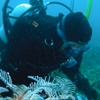General Description
Colony of individual polyps (hydranths) joined by root-like network of tubular stolons at the base. Colony shape is tree-like or bushy (arborescent). Colour: variable pale yellow to orange, gonothecae orange or pinkish. Up to 5 cm high.
Biology
Colonies of this species grow annually and become fertile in spring and summer.
Habitat
Still water on invertebrates, often on sponges and algae attached to jetties, to depths greater than 500 m.
Reefs
Distribution guide
Temperate to subantarctic waters worldwide. Southern Australia.
Species Group
Depth
Shallow (1-30 m)
Deep ( > 30 m)
Water Column
Max Size
5 cm
Diet
Plankton or Particles
Harmful
Generally not harmful but still able to sting bare skin.
Commercial Species
No
Global Dispersal
Recorded in Australia
Identify
Conservation Status
- DSE Advisory List : Not listed
- EPBC Act 1999 : Not listed
- IUCN Red List : Not listed





